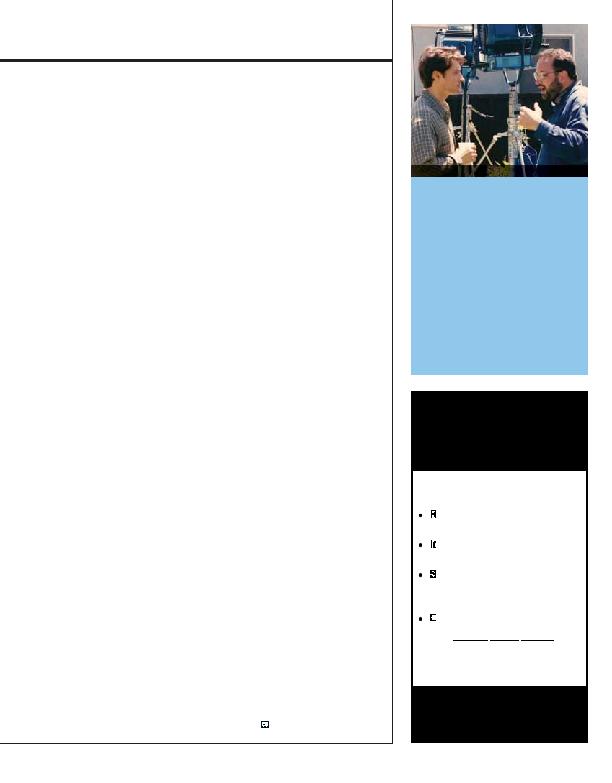
have to stay on the highway. You can take
those side roads and explore different
things. If you put the time and effort into
that outline phase, it's actually a much more
rewarding writing experience because you
can focus on the things that are important
when writing -- the character and the dia-
logue and the themes."
idays: "We got the sign off on Labor Day,"
he recalls. "We turned in our first draft at
Halloween, we got notes right away, turned
in our second draft at Thanksgiving, and
that's the draft Spielberg read. We had notes
with him right after and then we turned in
a draft by Christmas and did some refining."
story grounded and emotional, but he also
credits the legendary director-producer with
being skilled at interlacing humor with seri-
ous moments. "Where do you find those mo-
ments that give the audience a breath or a
moment of lightness in what would otherwise
be a very dark scene? It's a little embarrassing
sitting in a meeting with Steven Spielberg,"
Gough laughs, "and you're referencing his
movies when you try to make a point about
this film. For me, somebody who came to
Hollywood because of Steven Spielberg
movies, it's like an out-of-body experience."
spring, Dreamworks decided the script could
use a polish in the last hour. They turned to
Marti Noxon (Buffy the Vampire Slayer), who
had just finished the remake of Fright Night
for them. "Initially, it was just going to be a
week of work," she says, "and then it was
more than that. Everybody felt there was re-
ally solid stuff that had been done thus far."
But the catch was that Gough and Millar --
and an uncredited screenwriter after them
-- had created a story that was almost too
slick and sophisticated. "The feeling was
that we had an incredibly good foundation,
but for the genre and the audience they
were going for, it needed a more teen tone."
lationship between her and John. "At the
point I came [in], she wasn't really popping
as someone girls would like. So that was one
of the first orders of business -- bringing my
voice to that. Because God knows," she
pernatural romance."
that existed in earlier drafts of the script
with the relationships between John, Henri
and Sarah. "On the one hand," Noxon ex-
plains, "we wanted to deepen the character
stuff, find a few more moments of humor
and real teen-ness, and at the same time hit
that right balance of orienting the audience
to this world the book created. There's al-
ways, in any of these genre projects, an
enormous amount of consideration that
goes into how much people need to know
to grasp the story -- and how much is too
much? How much are they going to need to
feel grounded, and how much are they
going to need to feel that they understand
the stakes?" Noxon worked on the script's
interplanetary mythology and pared away
many of the more fantasy elements.
index cards for anything except action se-
quences. "I found that sometimes cards
made it start to feel too episodic to me," she
explains. "You usually know that some-
thing's wrong when you can move cards
around and it doesn't matter where they go.
I found I could get a little too arbitrary with
cards." Even her outlines tend to be written
more like a story than a list of bullet points.
"That tended to lead to a stronger structure
for me," Noxon says. "If I'm staying in it as
a story that I'm telling to myself, that tended
to lead to a better first pass on structure."
an imminent green light stems from all the
voices and feedback coming at the writer.
"You're writing as fast as you can and, in a
weird way, you just have to trust the process
and in the end see what you've got." One of
these voices was, again, Spielberg's, who
had a few thoughts on the film's main an-
tagonist, the alien commander (Kevin Du-
rand). "I certainly took some of my Buffy
villain training. He wanted him to be this
kind of lusty guy and that was just delight-
ful because it was definitely in the school
of Whedon." She laughs and adds, "On the
one hand, it was like a dream come true. I
was getting notes from Mr. Spielberg. And
on the other hand, it's like, `Jesus, I haven't
had any sleep. I don't know if I'm making
this worse.'"
Of
ff
Publishing for
worked with Scorsese, Spielberg and
Robert Rodriguez.
back issues of free newsletter at his blog:
jamespmercurio.blogspot.com
and scripts going into production